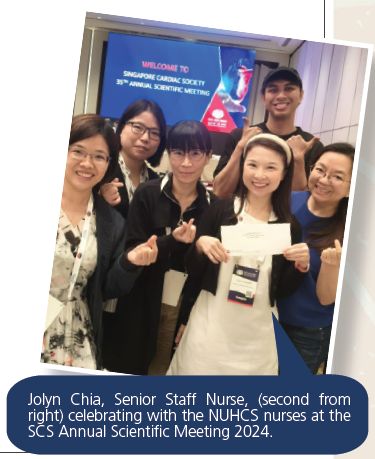How Nursing-led Research is Transforming Patient Care
A look into Evidence-based Practices (EBP) in wards and clinics
PULSE Issue 43 | July 2024
In the dynamic world of healthcare, keeping up with the latest scientific advancements is important to deliver effective and up-to-date patient-centric care. In the heart of this transformative approach at the National University Heart Centre, Singapore (NUHCS), is the Cardiovascular Evidence-based Nursing Collective (CENC). This dedicated nursing group is redefining the future of patient care through the latest research projects, empowering nurses to make significant impacts on clinical practice.
Nurturing Research Talents, Improving Care Quality
Evidence-Based Practice (EBP) in healthcare involves the use of the best research evidence, along with a nurse’s experience and a patient’s preferences, to make better decisions about patient care. Nurses play a crucial role in healthcare and are encouraged to carefully evaluate and apply the latest research and scientific evidence into practical processes, to improve the way they provide care. By doing so, they can enhance the quality of patient support and continuously improve their day-to-day practice.
Celebrated for their impact on patient care, two NUHCS nurses from CENC have been awarded the Nursing Innovation, Clinical Inquiry, Enabling Research (NiCER) award to support their groundbreaking projects. On top of a monetary grant, the NiCER award provides recipients with a comprehensive suite of resources including modular webinars and dedicated research mentors. These resources were designed to help the nurses achieve new strides in their areas of research interest, and most importantly, to bridge the gap between research and clinical care.
"I am passionate in my pursuits for Evidence-based Practice within nursing because I recognise that it ensures our care is grounded in the latest research, leading to better patient outcomes and continuous quality improvement."
- Lim Ellene, Senior Staff Nurse, Coronary Care Unit, NUHCS
 Awarded Top 5 Oral Presentations at the Official SCS Annual Scientific Meeting 2024
Awarded Top 5 Oral Presentations at the Official SCS Annual Scientific Meeting 2024
Jolyn Chin, Senior Staff Nurse, and Lee Choy Yee, Advanced Practice Nurse, Ward 63, NUHCS, showcased their research project at the 35th Annual Scientific Meeting 2024 by the Singapore Cardiac Society (SCS) held from 26 to 28 April 2024.
Their interventional study that compares the effects of Early Ambulation1 (EA) and Complete Rest in Bed (CRIB) in Non-ST Elevation Myocardial Infarction (NSTEMI)2 patients prior to coronary angioplasty3, showed that allowing NSTEMI patients to mobilise and walk earlier as compared to the traditional process of complete rest in bed, had reduced irregular heart rhythm events and did not compromise on patient safety before receiving coronary angioplasty treatment.
Based on its promising results and potential to change practice, this research study has emerged as one of the Top 5 Oral Presentations, underscoring the transformative potential of nurse-led research.
Pioneering Better Ways to Care
By challenging conventional practices and championing evidence-backed ideas, having the CENC within NUHCS sets the stage for cardiac nurses to take the lead in health innovation and promote optimal patient outcomes. It does so by grooming Evidence-based Resource Nurses (EBRN) within each cardiac unit, providing a structured framework for nurses to raise relevant questions, and leverage on the best available evidence to guide their decision-making on care interventions. In addition, the CENC constantly monitors the outcomes of newly launched measures to ensure their sustainability and relevance in the clinical setting, in turn boosting patient safety and the standard of care.
Learn how nurses drive positive change through Evidence-Based Practices:
- Reducing patient discomfort after procedures through early ambulation
For patients going through coronary angiographic procedures, a period of bed rest is usually recommended to prevent any recovery complications. However, extended rest in bed up to 24-hours can cause back pain, urinary discomfort and urinary retention, collectively resulting in frequent feedback of patient discomfort and dissatisfaction.
To address these issues, Lim Ellene, Senior Staff Nurse, and her team of nurses within the Coronary Care Unit, NUHCS, spearheaded a project to identify the safety and effects of empowering patients to get up and moving four-hours after the invasive coronary angiographic procedure.
By encouraging patient mobility four-hours after the procedure, the team found that back pain, urinary discomfort and urinary retention were reduced significantly, yet maintaining low levels of complication rates. The outstanding results from the pilot study has driven a change in practice guidelines within the cluster.
- Reducing pain & bruising through the Subcutaneous Heparin Injection Technique
Commonly, patients who receive subcutaneous4 heparin injections tend to complain about site pain and discomfort. With the aim to reduce patients’ bruising and pain associated with traditional subcutaneous heparin injections, a group of nurses from NUHCS led an EBP project titled Subcutaneous Heparin Injection Technique in the Cardiology general ward.
This project illustrated that by training nurses to perform the “10-second give, 10-second wait and 10-second hold” technique, it resulted in a drastic reduction of pain score and occurrences of postinjection bruising in patients. Due to its preliminary success, the project has been widely implemented by nurses across various units within the cluster, as part of daily practice.
The effect of these projects led by our EBRNs ripples across the cluster, motivating nurses to challenge the status quo and strive to refine the standards of patient care. Setting a precedent, the above-mentioned successful implementations by the CENC serves as an inspiration for more nurses across all settings to take ownership of their practice. By translating their EBP / research insights into clinical advances, nurses are actively transforming care by deriving better clinical decisions and patient outcomes.
1. Ambulate – the practice of getting patients up and moving.
2. NSTEMI – a partial heart attack that usually happens when the heart’s need for oxygen cannot be met.
3. Coronary Angioplasty – a minimally invasive procedure used to open blocked coronary arteries caused by coronary artery disease.
4. Subcutaneous – a mode of injection under the skin within the fatty tissue.
